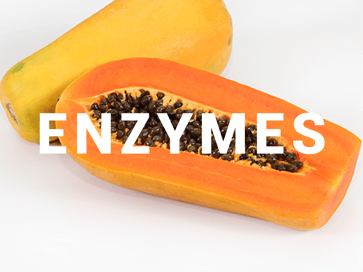Enzyme/Kinetics
Enzyme activity can be easily detected label-free in real-time with NanoCuvette™ One. All that is needed is 0.5 µL of sample and an UV-VIS spectrophotometer.
Download pdf here.
Enzymes - The catalysis of life
 Enzymes are biomolecules produced in living organisms. They are biocatalysts in function and speed up specific biochemical reactions. Biochemical reactions are chemical reactions happening in the living cell often with the aid of enzymes. As catalysts, enzymes can facilitate the same chemical reaction without being consumed. Enzymes are proteins and made of long chains of specific sequences of amino acids which fold into its unique shape. Enzymes have a cleft called the active site, which is the part of an enzyme to which substrates bind. The active site is the region where a reaction is catalyzed. When a substrate is in proximity, the enzyme forms a complementary shape to the substrate in order to bind the substrate. This concept is also known as the induced fit model. The processivity of enzymes is determined by its activity or the number of units of substrate it can form from a substrate.
Enzymes are biomolecules produced in living organisms. They are biocatalysts in function and speed up specific biochemical reactions. Biochemical reactions are chemical reactions happening in the living cell often with the aid of enzymes. As catalysts, enzymes can facilitate the same chemical reaction without being consumed. Enzymes are proteins and made of long chains of specific sequences of amino acids which fold into its unique shape. Enzymes have a cleft called the active site, which is the part of an enzyme to which substrates bind. The active site is the region where a reaction is catalyzed. When a substrate is in proximity, the enzyme forms a complementary shape to the substrate in order to bind the substrate. This concept is also known as the induced fit model. The processivity of enzymes is determined by its activity or the number of units of substrate it can form from a substrate.The enzyme activity is usually measured in a two step process using an enzyme assay. The assay can either measure on the disapperance of starch or the appearance of disaccharides. To measure either of these, the first step is to add a reactant, which for example enabels a color readout. In a second step, the color can be quantified spectrophotometrically and the enzyme activity measured.
Introducing label-free kinetics measurements
Direct label-free detection of enzymatic activity with a substrate can be monitored with the change in the intrinsic property, refractive index of the solution as product is formed over time. Traditionally a refractometer has been required for the determination of refractive index. The novel NanoCuvette™ One has a built-in optical filter allowing to measure refractive index change due to enzymatic reaction in real time using a conventional spectrophotometer.
All that is needed is our NanoCuvette™ One, 0.5 µL sample and an UV-VIS spectrophotometer for instance Shimadzu, PerkinElmer, Thermo Ficher, Mettler Toledo, VWR or similar.
Conclusion
Traditionally a specialized refractometer has been required for determination of the refractive index. However, with the innovative NanoCuvette™ One, an optical filter is installed in a cuvette, allowing determination of the refractive index to be carried out over time in a standard spectrophotometer. This way even enzyme kinetics can be measured label-free with a conventional spectrophotometer down to 0.5 µL of sample.
Contact
Copenhagen Nanosystems ApS,
Hørmarken 2, DK-3520 Farum, Denmark
Tel: +45 36 99 27 46
www.nanocuvette.com